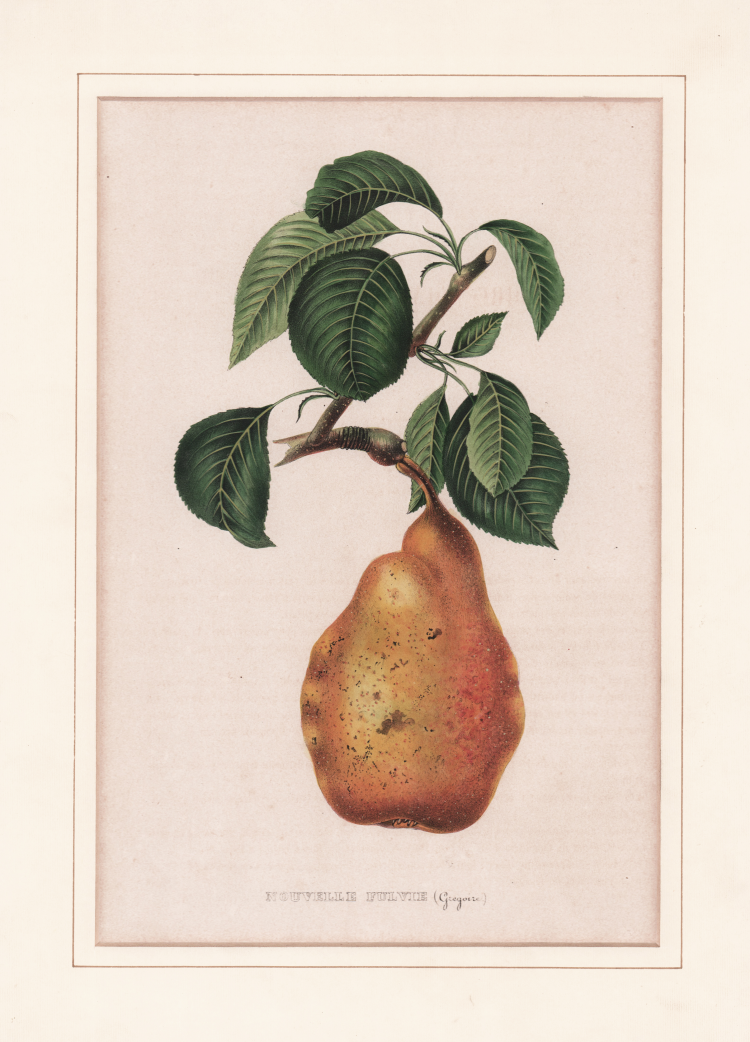



| Reference: | S1297 |
| Author | Alexandre Joseph Désiré Bivort |
| Year: | 1853 ca. |
| Printed: | Bruxelles |
| Measures: | 195 x 300 mm |


| Reference: | S1297 |
| Author | Alexandre Joseph Désiré Bivort |
| Year: | 1853 ca. |
| Printed: | Bruxelles |
| Measures: | 195 x 300 mm |
Colour litograph, 1853-1960, printed on contemporary paper, good condition.
The plate is taken from Annales de pomologie belge et étrangère (1853–1860), an illustrated pomology review published annually by the Belgian Commission Royale de Pomologie, with Alexandre Bivort as secretary of the editorial committee (effectively editor in chief). It was printed in Brussels, first by F. Parent (1853-1858) and then by his widow and son (1859-1860).
Apart from Bivort himself, contributors to the Annales included Charles and Ernest Baltet, Laurent de Bavay, Jules de Liron d’Airoles, Antoine-Joseph Gailly, Charles Auguste Hennau, Alfred Loisel, Auguste Royer, Félix Sahut, and Michel Scheidweiler.
Alexandre Joseph Désiré Bivort (1809–1872) was a Belgian horticulturalist, specialising in pomology. He was particularly influential in systematising the nomenclature of strains of pear.
He devoted much of his time to the study of griculture, eventually becoming a full-time horticulturalist. In 1840 he acquired the seed collection of Jean-Baptiste Van Mons, numbering about 20,000 seeds, and gradually transported it to his own property at Saint-Remy-Geest. In 1854 he became the director of the Société Van Mons. He corresponded with many leading international pomologists, and was the secretary of the editorial committee of the Commission Royale de Pomologie's Annales de pomologie belge et étrangère (1853–1860), to which he was a substantial contributor.
Bibliografia
Émile Rodigas, "À la mémoire d’Alexandre Bivort", Bulletins d’arboriculture, de floriculture et de culture potagère (1872), p. 275; Anne-Marie Bogaert-Damin, "L’illustration des revues d’horticulture en Belgique au XIXe siècle", In Monte Artium, 7 (2014), pp. 155-176.
Alexandre Joseph Désiré Bivort (1809-1872)
|
Alexandre Joseph Désiré Bivort (1809–1872) was a Belgian horticulturalist, specialising in pomology. He was particularly influential in systematising the nomenclature of strains of pear.
Bivort was born at Fleurus on 9 March 1809. He was educated at the industrial school in Melle and at the college in Aalst, where he graduated secondary school at the age of fifteen. While working in the family coal business at Jumet, he devoted much of his time to the study of griculture, eventually becoming a full-time horticulturalist. In 1840 he acquired the seed collection of Jean-Baptiste Van Mons, numbering about 20,000 seeds, and gradually transported it to his own property at Saint-Remy-Geest. In 1854 he became the director of the Société Van Mons. He corresponded with many leading international pomologists, and was the secretary of the editorial committee of the Commission Royale de Pomologie's Annales de pomologie belge et étrangère (1853–1860), to which he was a substantial contributor. He died in Fleurus on 8 May 1872.
|
Alexandre Joseph Désiré Bivort (1809-1872)
|
Alexandre Joseph Désiré Bivort (1809–1872) was a Belgian horticulturalist, specialising in pomology. He was particularly influential in systematising the nomenclature of strains of pear.
Bivort was born at Fleurus on 9 March 1809. He was educated at the industrial school in Melle and at the college in Aalst, where he graduated secondary school at the age of fifteen. While working in the family coal business at Jumet, he devoted much of his time to the study of griculture, eventually becoming a full-time horticulturalist. In 1840 he acquired the seed collection of Jean-Baptiste Van Mons, numbering about 20,000 seeds, and gradually transported it to his own property at Saint-Remy-Geest. In 1854 he became the director of the Société Van Mons. He corresponded with many leading international pomologists, and was the secretary of the editorial committee of the Commission Royale de Pomologie's Annales de pomologie belge et étrangère (1853–1860), to which he was a substantial contributor. He died in Fleurus on 8 May 1872.
|